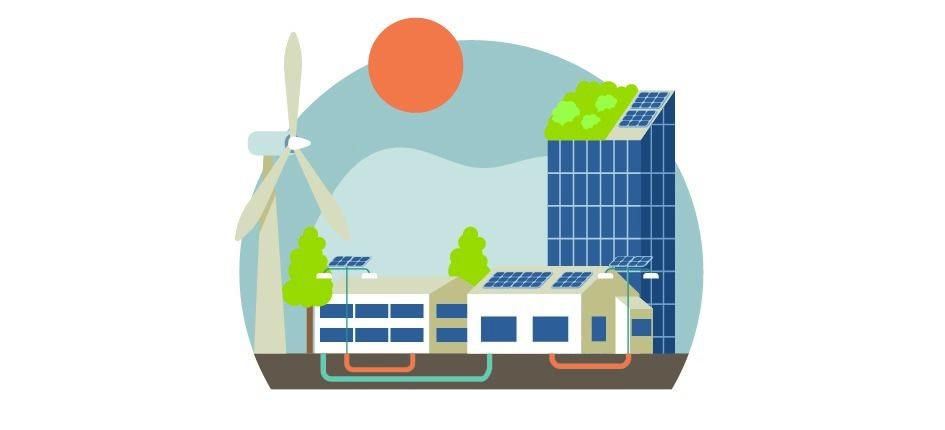Wind and solar projects will have to be built at a rapid rate alongside the necessary innovations and storage technologies to improve efficiency and manage energy demands. Other baseload power generation options including advanced nuclear and geothermal are also making impressive headway, but these have a long way to go before they can reach commercial scale.
Innovations in Solar Technologies:
Solar PV plays a key role in the decarbonization of the energy sector. To meet 2050 net-zero goals, the IEA projects that solar PV must account for 35% of the overall global energy mix, with renewables — namely solar and wind — making up about 90% of all energy generation. Zeroing on a region like New York, which is the US leader in community solar deployments, we can see the rapid acceleration of community solar projects. Oya Renewables, a Canadian Solar developer, recently received financing worth over $216M from the City National Bank, Greenprint Capital, CIT Power and Energy and Monarch Private Capital. These various rounds of financing will support 15 community projects in the region. Another Canadian solar developer, Silfab Solar, also recently received an influx of funding to support projects in the US. It received $125M to support the development of a third facility in the US focusing on domestic PV cell and module production to support domestic supply chains with the goal of producing 1 GW of cell production.
To support the growing solar industry it is critical to ensure that solar intelligence is available as well. SmartHelio a predictive solar software solution provider based out of Lausanne, Switzerland uses AI to measure current, voltage, weather analysis to provide suggestions on how to optimize and maintain systems. The company raised $5M in seed funding last December. Two other Switzerland based companies optimizing solar projects include Insolight and Voltris. Insolight recently raised a Series B round of $4.9M to support installations across Switzerland and France to optimize agricultural and electricity production using a system that controls light transmission to plants and generates electricity through solar panels. Voltris also raised a $1.5M pre-seed round that will enable them to ramp up the development of their solar modules that allow for double use of greenhouse area as well.
There have also been start-ups improving on the actual PV systems themselves as well. Traditionally, crystalline silicon PV make up most of the solar PV module market. However, their conversion efficiency has been known to top out around 22% which will pose a challenge when meeting the growing energy demands. Thin film solar innovations address many of the challenges associated with silicon PV and can be deployed in areas where silicon PV is not feasible or appropriate. Perovskite thin film cells can absorb a wider spectrum of light and have higher conversion efficiencies. Perovskite treated glass, when layered over silicon PV cells in tandem modules, can improve conversion efficiencies without substantial manufacturing changes. In April 2022, Tandem PV raised $6M to accelerate the construction of its pilot manufacturing facility in California. Caelux, another California based perovskite tandem cell manufacturer also raised $12M in a seed round to support product and commercial deployment. Examples of innovative approaches to efficiency gains through thin film technologies include using dye coatings (ie; Ubiquitous Energy), quantum dot semiconductor materials (ie; Nanoco and QD Solar) and organic pv materials (ie: Heliatek) Support from the Inflation Reduction Act has also supported the development of perovskite solar cells and domestic supply chain growth.
Long Duration Energy Storage:
With increased solar and wind penetration, comes the need for storage as well. Companies like Fu-Gen, an independent power producer based out of Switzerland, that operates a variety of renewable projects including solar and wind, is now also focusing efforts to support sustainable storage through its Power-to-X project as well. Last year, Fu-Gen received more than €320m for renewables growth and will use funding to support investments in the UK, Finland, other regions and to support battery storage technologies
As renewable penetration increases over the years, critical challenges related to intermittency and storage must be addressed. At least 10 hours will be required as back up for Long Duration Energy Storage (LDES) systems to support these developments. Although certain LDES systems and batteries may not have the highest round-trip efficiencies, many are looking at potentially curtailed and cheap power generation to supply their systems and to discharge when prices are high. As a result, many LDES solution providers are looking to regions like California where there can be an oversupply of power during different times of the days.
Governments are aware of the need for growth and development in the LDES sector and The U.S. Department of Energy, the Australian Renewable Energy Agency (ARENA) and the UK’s Department for Business, Energy and Industrial Strategy (BEIS) have invested close to $800M in different emerging LDES technologies. In addition to public funding, substantial private funding has gone into this space as well. Form Energy, a provider of iron air batteries with 100+ storage capacity for seasonal storage has raised over $690M in the past two years. Hydrostor, a Canadian company that compresses air using an underwater adiabatic system raised over $250M from Goldman Sachs last year to develop projects in Australia and California. Energy Vault, a Swiss based company also using gravitation storage techniques, raised over $290M dollars in the past two years to support their expansion.
Nuclear Fission and Advanced Nuclear Reactor Developments
One of the ways to achieve net zero without having to rely on intermittent sources like wind and solar is to invest and further develop nuclear fission reactors. These include traditional fission and advanced nuclear reactors. For example, Canada has been playing a leading role in the development and integration of grid-scale small modular reactors (SMRs). The Ontario Power Generation utility, with funding support from Canada’s Infrastructure Bank, will lead a project in Darlington, Ontario to support Canada’s efforts to cut emissions by 2030 to below 2005 levels and reach net zero emissions by 2050. This also aligns with Canada’s Small Modular Reactor Action Plan to bring together stakeholders to support smaller, simpler and cheaper nuclear energy systems to support these aggressive decarbonization efforts.
One company working to expand advanced nuclear reactors is Last Energy, a Washington DC based company that claims they can build a 20MW reactor in two years and for only $100M. They recently closed a few deals in Poland and the UK to develop their reactors however regulatory approval to begin construction on these reactors remains a key challenge.
Outside of advanced nuclear reactors, larger fission projects are gaining popularity to also meet decarbonization goals. For example, last November the UAE and the US signed a critical deal that will deploy $100 billion to generate 100 gigawatts of clean energy by 2035. This deal will support the construction of the largest single-site solar power plant and a nuclear power plant as well.
Geothermal:
Other technologies to generate power include geothermal technologies that leverage the heat continuously produced within the Earth's crust to provide renewable energy. Advanced geothermal techniques can support greater access to this type of renewable energy. Additionally, heat sequestered from geothermal sources can be used for industrial applications. Some key players in the geothermal space include Eavor, Greenfire Energy, Fervo Energy, Ormat and Altarock.
Eavor, a company based out of Calgary, Canada recently announced a successful demonstration project in New Mexico which has triggered a follow on investment from bp Ventures. Additionally, they have plans for projects in Germany and Bavaria as well. XGS Energy, a geothermal company based out of California, raised $19M in financing to support their closed loop technology.
Oil and gas majors are leveraging their expertise and buying into geothermal. This significantly reduces drilling risks and brings much needed knowledge to support scaling up the industry. Also, for the industry to expand, deep drilling companies like GA Drilling and Quaise, if successful could unlock new geographies and boost geothermal power globally. Policies supporting geothermal power include the Inflation Reduction Act’s financial support and the goals to cut costs by 90% by 2030. Additionally, in 2019 the California Public Utilities Commission created the goal to supply 2900MW of power into the grid by 2030 from geothermal sources.
Looking Ahead:
With wind and solar already operating at commercial scale these technologies will make up the highest percentage of renewable projects supporting net zero. To address this growth, grid scale LDES systems through electrochemical battery, thermal, and gravitational solutions will also have to be co-developed. However, if the regulatory challenges associated with advanced nuclear and the technical challenges with deep drilling geothermal are addressed in the coming years, these solutions can provide clean virtually carbon free emissions as well and may make up a higher percentage of the energy mix than they are currently. Additionally, investments in the nuclear fusion space as well are supporting the growth of an industry that has yet to prove itself at the demonstration scale but if successful then it might be possible for fusion to be a long term solution provider for carbon free, safe, baseload power generation.







